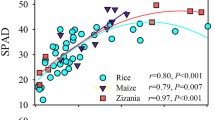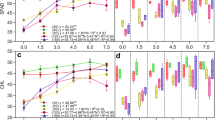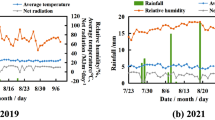Abstract
Applying appropriate nitrogen (N) rates is a big challenge to farmers when they need to earn maximum yield along with lowering leached N. It is hard to synchronize soil N availability with crop N needs due to the variation of weather conditions and its effects on crop growth. In this respect, the SPAD chlorophyll meter has been used extensively to analyze rapidly leaf chlorophyll and nitrogen status. However, it has not been established how the SPAD readings are correlated with wheat grain yield and growth under variable field and weather conditions. Therefore, the objective of this study was to determine the relationship between SPAD chlorophyll readings and leaf N status along with other agronomic parameters like yield and leaf area index. Two-year field experiments were carried out in 2015–2016 and 2016–2017. Variable alternate furrow irrigation (VAFI) and ordinary furrow irrigation (OFI) were the irrigation strategies, and in-furrow planting (IFP) and on-ridge planting (ORP) defined the planting methods. Three N application rates at 0, 150, and 300 kg N ha−1 indicated N variation. Results indicated that spring cold had negative effects on SPAD readings and especially leaf N concentration in the first year. The SPAD values were homogeneous in the second year with favorable weather conditions, and it was classified in three intervals 28–35, 35–45, and 45–50 in non-fertilized, 150 kg N ha−1 and 300 kg N ha−1, respectively. Since the grain yield was similar in 150 kg N ha−1 and 300 kg N ha−1, the values of SPAD readings at 40–45 could be appropriate values for producing optimum wheat growth and grain yield. However, higher grain protein concentration might need higher leaf N concentration and subsequently higher SPAD values. Leaf N concentration positively correlated with SPAD values (R2 = 0.64). Linear relationships between grain yield and grain N% and SPAD readings showed higher accuracy in the second year (R2 = 0.71 and 0.79, respectively). Moreover, relative yield and SPAD readings resulted in a higher accurate model than the absolute values. Therefore, using this model, chlorophyll meter reading can be used by farmers as an alternative complementary tool for predicting crop N status and obtaining higher wheat grain yield.














Similar content being viewed by others
References
Arregui, L. M., Lasa, B., Lafarga, A., Irañeta, I., Baroja, E., & Quemada, M. (2006). Evaluation of chlorophyll meters as tools for N fertilization in winter wheat under humid Mediterranean conditions. European Journal of Agronomy, 24, 140–148.
Chapman, H. D., & Pratt, P. F. (1961). Methods of analysis for soil, plant and water. Berkely: UC Division of Agriculture.
Debaeke, P., Rouet, P., & Justes, E. (2007). Relationship between the normalized SPAD index and the nitrogen nutrition index: application to durum wheat. Journal of Plant Nutrition, 29, 75–92.
Errecart, P. M., Agnusdei, M. G., Lattanzi, F. A., & Marino, M. A. (2012). Leaf nitrogen concentration and chlorophyll meter readings as predictors of tall fescue nitrogen nutrition status. Field Crops Research, 129, 46–58.
Ghimire, B., Timsina, D., & Nepal, J. (2015). Analysis of chlorophyll content and its correlation with yield attributing traits on early varieties of maize (Zea mays L.). Journal of Maize Research and Development, 1, 134–145.
Ghosh, M., Swain, D. K., Jha, M. K., Tewari, V. K., & Bohra, A. (2020). Optimizing chlorophyll meter (SPAD) reading to allow efficient nitrogen use in rice and wheat under rice-wheat cropping system in eastern India. Plant Production Science, 23, 1–16.
Giunta, F., Motzo, R., & Deidda, M. (2002) SPAD readings and associated leaf traits in durum wheat, barley and triticale cultivars. Euphytica, 125, 198–205
Idnani, L. K., & Singh, R. J. (2008). Effect of irrigation regimes, planting and irrigation methods and arbuscular mycorrhizae on productivity, nutrient uptake and water use in summer greengram (Vigna radiata var radiata). Indian Journal of Agricultural Sciences, 78, 53–57.
Kendal, E. (2015). Relationship between chlorophyll and other features in durum wheat (Triticum turgidum L. var. durum) using SPAD and biplot analyses. Journal of Agricultural Science and Technology, 17, 1873–1886.
Kızılgeçia, F., Akıncıb, C., Albayrakb, Ö., & Yıldırımb, M. (2017). Nitrogen effects on SPAD meter and grain yield relationships in F2 durum wheat populations. Scientific Journal of Crop Science, 6, 176–182.
Lemaire, G., Plénet, D., & Grindlay, D. (1997). Leaf N content as an indicator of crop N nutrition status. Diagnosis of the nitrogen status in crops (pp. 189–199). Springer.
Matsunaka, T., Watanabe, Y., Miyawaki, T., & Ichikawa, N. (1997). Prediction of grain protein content in winter wheat through leaf color measurements using a chlorophyll meter. Soil Science and Plant Nutrition, 43, 127–134.
Mehrabi, F., & Sepaskhah, A. R. (2018). Interaction effects of planting method, irrigation regimes, and nitrogen application rates on yield, water and nitrogen use efficiencies of winter wheat (Triticum aestivum). International Journal of Plant Production, 12, 265–283.
Mehrabi, F., & Sepaskhah, A. R. (2019a). Winter wheat yield and DSSAT model evaluation in a diverse semi-arid climate and agronomic practices. International Journal of Plant Production, 14, 221–243.
Mehrabi, F., & Sepaskhah, A. R. (2019b). Partial root zone drying irrigation, planting methods and nitrogen fertilization influence on physiologic and agronomic parameters of winter wheat. Agricultural Water Management, 223, 105688.
Mehrabi, F., & Sepaskhah, A. R. (2021). Soil drainage water and nutrient leaching in winter wheat field lysimeters under different management practices. International Journal of Plant Production, 15, 13–28.
Mehrabi, F., Sepaskhah, A. R., & Ahmadi, S. H. (2021). Winter wheat root distribution with irrigation, planting methods, and nitrogen application. Nutrient Cycling in Agroecosystems, 119, 231–245.
Pirmoradian, N., Sepaskhah, A. R., & Maftoun, M. (2004). Deficit irrigation and nitrogen effects on nitrogen-use efficiency and grain protein of rice. Agronomie, 24, 143–153.
Prost, L., & Jeuffroy, M. H. (2007). Replacing the nitrogen nutrition index by the chlorophyll meter to assess wheat N status. Agronomy for Sustainable Development, 27, 321–330.
Ravier, C., Quemada, M., & Jeuffroy, M. H. (2017). Use of a chlorophyll meter to assess nitrogen nutrition index during the growth cycle in winter wheat. Field Crops Research, 214, 73–82.
Rostami, M., Koocheki, A. R., Mahallati, M. N., & Kafi, M. (2008). Evaluation of chlorophyll meter (SPAD) data for prediction of nitrogen status in corn (Zea mays L.). American-Eurasian Journal of Agricultural and Environmental Science, 3, 79–85.
Schlichting, A. F., Bonfim-Silva, E. M., Silva, M. D. C., Pietro-Souza, W., da Silva, T. J., & Farias, L. D. N. (2015). Efficiency of portable chlorophyll meters in assessing the nutritional status of wheat plants. Revista Brasileira De Engenharia Agricola e Ambiental, 19, 1148–1151.
Siband, P., Loyce, C., Witt, C., & Dingkuhn, M. (2001). Evaluer le statut azoté. In Modélisation des agroécosystèmes et aide à la décision, p. 95.
Simkó, A., & Veres, S. (2019). Evaluation of the correlation between SPAD readings and absolute chlorophyll content of maize under different nitrogen supply conditions. Acta Agraria Debreceniensis, 2, 121–126.
Uchino, H., Watanabe, T., Ramu, K., Sahrawat, K. L., Marimuthu, S., Wani, S. P., & Ito, O. (2013). Calibrating chlorophyll meter (SPAD-502) reading by specific leaf area for estimating leaf nitrogen concentration in sweet sorghum. Journal of Plant Nutrition, 36, 1640–1646.
Vaughan, B., Barbarick, K. A., Westfall, D. G., & Chapman, P. L. (1990). Spring nitrogen fertilizer recommendation models for dryland hard red winter wheat. Agronomy Journal, 82, 565–571.
Vidal, I., Longeri, L., & Hétier, J. M. (1999). Nitrogen uptake and chlorophyll meter measurements in spring wheat. Nutrient Cycling in Agroecosystems, 55, 1–6.
Xiong, D., Chen, J., Yu, T., Gao, W., Ling, X., Li, Y., Peng, Sh., & Huang, J. (2015). SPAD-based leaf nitrogen estimation is impacted by environmental factors and crop leaf characteristics. Scientific Reports, 5, 13389.
Yang, H., Yang, J., Lv, Y., & He, J. (2014). SPAD values and nitrogen nutrition index for the evaluation of rice nitrogen status. Plant Production Science, 17, 81–92.
Yuan, Z., Ata-Ul-Karim, S. T., Cao, Q., Lu, Z., Cao, W., Zhu, Y., & Liu, X. (2016). Indicators for diagnosing nitrogen status of rice based on chlorophyll meter readings. Field Crops Research, 185, 12–20.
Yue, X., Hu, Y., Zhang, H., & Schmidhalter, U. (2020). Evaluation of both SPAD reading and SPAD index on estimating the plant nitrogen status of winter wheat. International Journal of Plant Production, 14, 67–75.
Zhang, K., Yuan, Z., Yang, T., Lu, Z., Cao, Q., Tian, Y., Zhu, Y., Cao, W., & Liu, X. (2020). Chlorophyll meter–based nitrogen fertilizer optimization algorithm and nitrogen nutrition index for in-season fertilization of paddy rice. Agronomy Journal, 112, 288–300.
Zhao, B., Ata-Ul-Karim, S. T., Liu, Z., Zhang, J., Xiao, J., Liu, Z., Qin, A., Ning, D., Yang, Q., Zhang, Y., & Duan, A. (2018). Simple assessment of nitrogen nutrition index in summer maize by using chlorophyll meter readings. Frontiers in Plant Science, 9, 11.
Acknowledgements
This research was supported in part by a research project funded by Grant no. 99-GR-AGR 42 of Shiraz University Research Council, Drought Research Center, the Center of Excellent for On-Farm Water Management, and Iran National Science Foundation (INSF).
Author information
Authors and Affiliations
Contributions
FM as Ph.D. student, conducted the research in field, analyzed data and prepared the first draft of manuscript. ARS as Dissertation Supervisor, planned the research project, supervised the experiment, controlled the data and analysis and edited the manuscript.
Corresponding author
Ethics declarations
Conflict of interest
On behave of all authors, the corresponding author declaire that there is no conflict of interest among the authors.
Rights and permissions
About this article
Cite this article
Mehrabi, F., Sepaskhah, A.R. Leaf Nitrogen, Based on SPAD Chlorophyll Reading Can Determine Agronomic Parameters of Winter Wheat. Int. J. Plant Prod. 16, 77–91 (2022). https://doi.org/10.1007/s42106-021-00172-2
Received:
Accepted:
Published:
Issue Date:
DOI: https://doi.org/10.1007/s42106-021-00172-2




